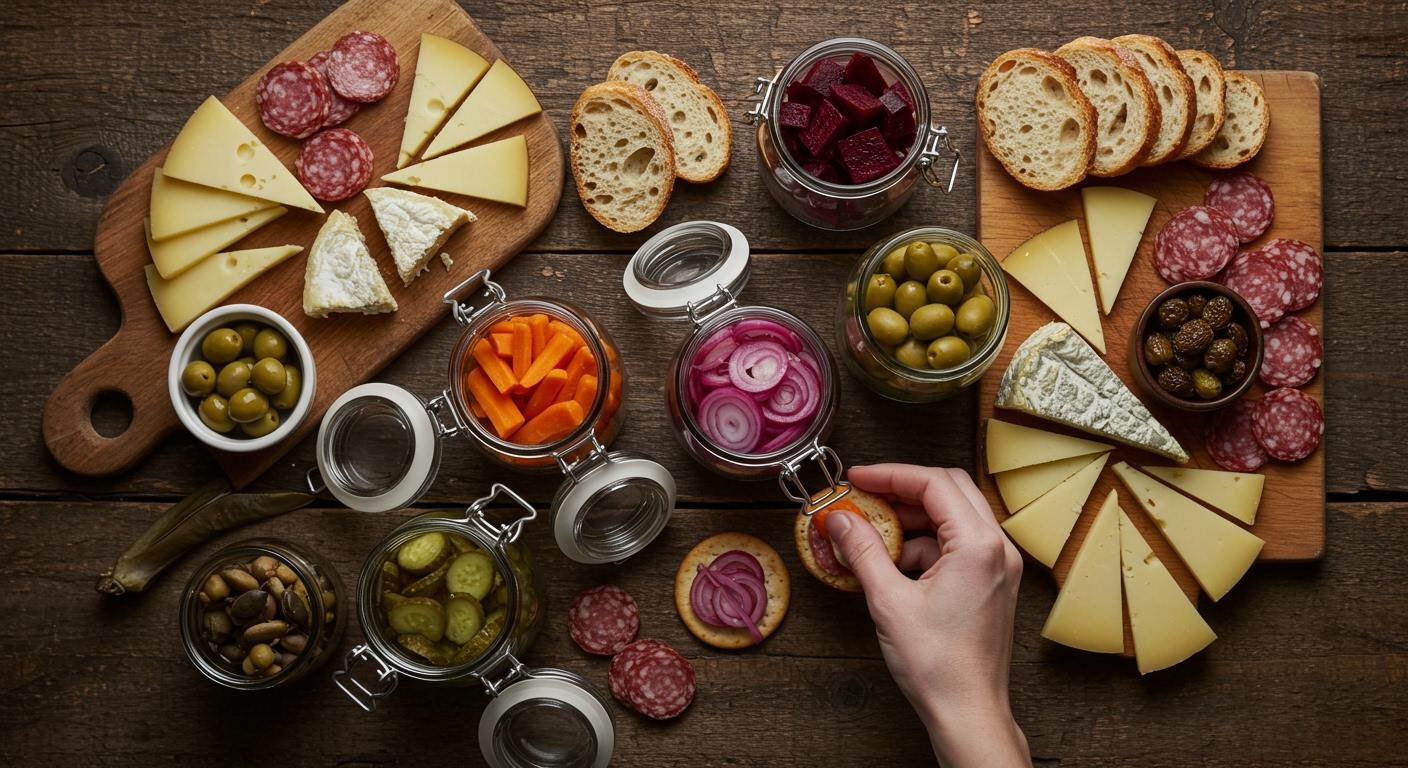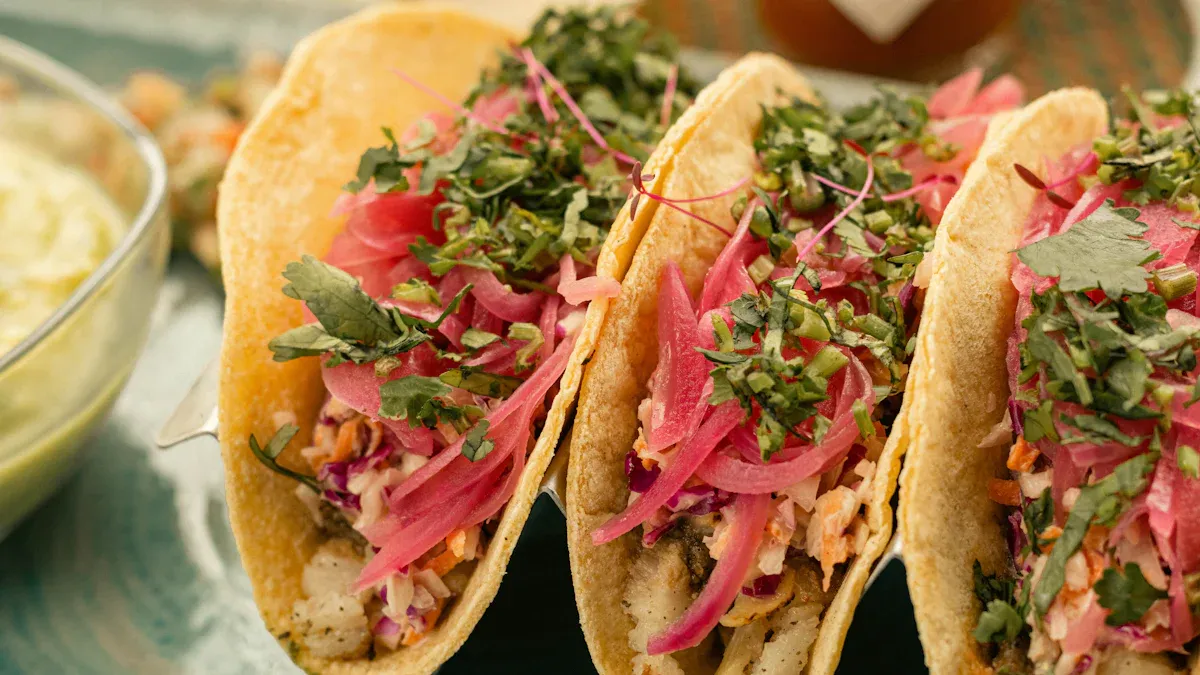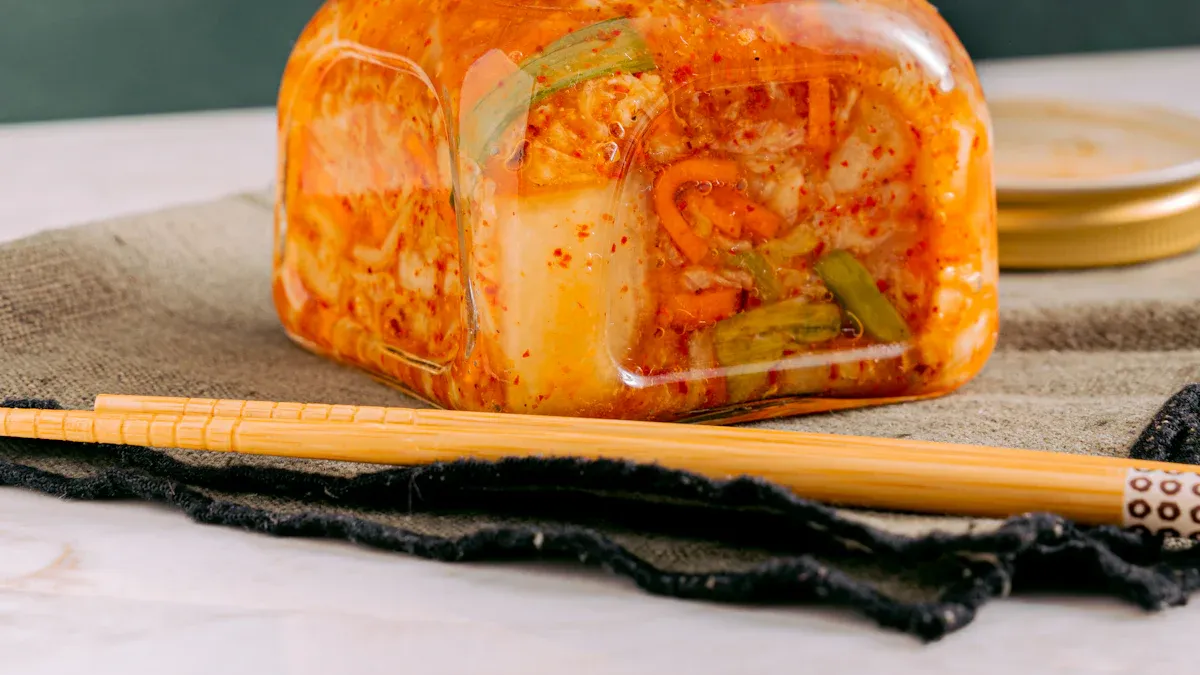The Secret to Delicious Pickled Veggies Pairings
Table of Contents

The secret to delicious pairings is simple. You balance bold, fermented proteins with the bright crunch of pickled veggies. The market for pickled vegetables reached $4.2 billion in 2024, showing how many people enjoy these tasty vegetables. You can elevate your meals with these can’t-miss pickles:
- Kimchi with Pickled Radish
- Tempeh with Pickled Red Onions
- Yogurt with Pickled Cucumbers
This guide helps you master these delicious pickled combinations.
Pairing Your Pickled Veggies

You can unlock amazing flavors by pairing your proteins correctly. The science of flavor pairing often uses contrast. For example, acidity cuts through richness, and coolness balances spice. This creates a more exciting meal. Let’s explore how you can use these ideas with your favorite proteins and pickled veggies.
With Spicy & Pungent Proteins
Spicy proteins bring exciting heat to your plate. Think of gochujang pork sausage or spicy ham. These foods have a bold, pungent flavor. The key is to balance this heat with something cool and refreshing. You should choose mild, sweet pickles to cut through the spice.
- Why it works: The “Spicy and Cool” principle creates a dynamic experience. The crisp, cool vegetables offer relief from the heat. The sweetness of the pickles also contrasts with the savory, spicy protein.
- Best Pickles: Try pickled daikon radish or carrots. Their mild flavor and satisfying crunch are perfect. A spicy ham lettuce wrap becomes incredible with these pickled vegetables inside. These pickles do not overpower the main dish. They simply make it better.
With Earthy & Nutty Proteins
Earthy proteins have deep, savory flavors. You find these notes in foods like tempeh, lentils, and mushrooms. These foods can sometimes taste a little heavy. You need a pairing that brightens them up. Sharp, acidic pickles are the perfect solution.
Pro-Tip: The “food pairing hypothesis” suggests that ingredients with shared flavor compounds taste good together. For example, some chocolates and cheeses share many flavor compounds. This science helps explain why certain pairings feel so right.
- Why it works: The “Acid and Fat” principle is at play here. The sharp acidity from the pickles cuts through the dense, nutty flavor of the protein. This contrast makes the entire dish feel lighter and more vibrant.
- Best Pickles: Pickled red onions add a sharp, zesty bite that lifts the earthy notes of tempeh. Pickled jalapeños can also add a pop of heat and acidity. These pickles introduce a bright flavor that makes the vegetables in your dish stand out.
With Creamy & Tangy Proteins
Creamy proteins like Greek yogurt or labneh have a smooth texture and a tangy taste. Labneh is a thick yogurt cheese. It is tangier than cream cheese but subtler than goat cheese. Your goal is to complement this existing tang, not compete with it. You can use sweet or zesty pickles to create harmony.
- Why it works: This pairing focuses on harmony. The sweetness of certain pickles balances the sourness of the yogurt. Zesty pickles, like classic dills, can echo the tang in a pleasing way.
- Best Pickles: Sweet pickled beets add a beautiful color and earthy sweetness to a yogurt bowl. For a savory option, add classic dill pickles to a Mediterranean mezze platter. You can also use other pickled vegetables like artichoke hearts or peppers. These vegetables add a new layer of flavor and texture. The right pickled veggies make your creamy dishes more complex and delicious.
Making Your Own Fermented Vegetables

You can easily make delicious pickled veggies at home. This gives you control over the flavor and ingredients. There are two main methods you can try. One method is quick pickling with vinegar. The other method is lacto-fermentation with a salt brine. This second method creates beneficial probiotic bacteria. Let’s explore a recipe for each.
Quick Pickled Red Onions
Quick pickles are not the same as traditional pickling, which creates shelf-stable pickles. Instead, you use a vinegar-based brine to infuse vegetables with flavor. The process is very fast. You can enjoy your pickles in just a few hours. This recipe is perfect for beginners.
Choosing Your Vinegar You have many options for this recipe. White wine vinegar offers a mild flavor. Other vinegars create different results:
- Apple cider vinegar: Adds a slightly sweeter taste.
- Red wine vinegar: Gives the onions a darker color.
- Distilled white vinegar: Provides a harsher, more intense flavor.
- Rice vinegar: Offers a light and sweet profile. You should avoid strong vinegars like balsamic or malt. Their flavors can overpower the onions.
Fast & Zesty Red Onion Recipe This simple recipe creates a bright, tangy topping for many dishes.
- Prepare the Onion: Thinly slice one large red onion. Place the slices into a clean pint-sized glass jar.
- Make the Brine: In a small saucepan, combine 1/2 cup of water, 1/2 cup of your chosen vinegar, 1 tablespoon of sugar, and 1 1/2 teaspoons of salt.
- Heat the Brine: Warm the mixture over medium heat. Stir until the sugar and salt dissolve completely. You do not need to boil it.
- Combine and Wait: Carefully pour the hot brine over the onion slices in the jar. Let it cool to room temperature.
- Refrigerate: Once cool, seal the jar and place it in the refrigerator. The onions will be ready in about two hours, but their flavor is best after 24 hours.
Storage Tip: These quick pickles are not shelf-stable. You must store them in the refrigerator. They will last for about two weeks. Always use a clean fork to serve them. This prevents contamination and helps them last longer.
This pickled red onion recipe is perfect for tempeh tacos or avocado toast.
Simple Pickled Probiotic Veggies
You can create pickled probiotic veggies through a process called lacto-fermentation. This method uses a simple salt-and-water brine. The salt helps healthy bacteria (probiotics) grow. These bacteria preserve the vegetables and add a complex, tangy flavor. This recipe for fermented carrot sticks is a great way to start making your own fermented vegetables.
Safety First! 🧑🔬 Food safety is very important for a successful fermentation. You can avoid mold and spoilage with these simple rules:
- Use Clean Tools: Always start with very clean jars, weights, and utensils.
- Keep Vegetables Submerged: Your vegetables must stay 1-2 inches under the brine. Air exposure allows mold to grow.
- Watch the Temperature: Keep your fermenting vegetables in a cool, dark place. The ideal temperature is around 68-72°F. A warmer room increases the risk of spoilage.
- Use Enough Salt: The correct salt ratio is crucial. It prevents bad bacteria from growing.
Probiotic Fermented Carrot Sticks Recipe This recipe creates crunchy, tangy, and gut-healthy lacto-fermented vegetables.
- Prepare the Vegetables: Wash and peel 4-5 medium carrots. Cut them into sticks that are slightly shorter than your quart-sized jar. You can also add 2-3 thin slices of ginger for extra flavor.
- Calculate Your Brine: Place the carrot sticks and ginger into the jar. Fill the jar with filtered water until the vegetables are covered. Pour that water into a measuring cup to see how much you need. For these harder vegetables, you want a 2% salt brine. To get the right amount of salt, multiply the amount of water in grams by 0.02. This will give you the grams of salt needed.
- Mix the Brine: Add the correct amount of unrefined sea salt to the water. Stir until the salt is fully dissolved.
- Combine and Submerge: Pour the saltwater brine back over the carrots. Make sure the vegetables are completely submerged. Use a fermentation weight to keep them down.
- Ferment: Seal the jar with an airlock lid, or cover it loosely. Let it sit at room temperature for 5-7 days. You may see bubbles, which means the fermentation is working. Taste a carrot after 5 days to check the flavor.
- Store: Once the fermented carrot sticks reach a flavor you like, move the jar to the refrigerator. This will slow the fermentation process.
These lacto-fermented vegetables are a fantastic probiotic snack. You can also chop them up and stir them into kimchi fried rice for a crunchy, tangy boost.
Boosting Gut Health With Ferments
Eating fermented vegetables is a great way of boosting gut health. These foods are full of beneficial bacteria that support your digestive system. Your gut contains a community of microorganisms. A healthy gut balance is essential for your overall health. Adding fermented foods to your diet can improve this balance and offer many benefits.
The Power of Probiotics
Probiotic foods contain live, beneficial bacteria. These microorganisms help maintain a healthy gut. When you eat fermented vegetables, you introduce these helpful microbes to your system. Many commercial probiotic products contain 1 to 10 billion colony-forming units (CFUs). A daily intake of around 1 billion CFUs is a good target for general health. Lacto-fermented vegetables are a great source of these bacteria. Common strains you might find in your fermented vegetables include:
- Lactobacillus plantarum
- Lactobacillus brevis
- Lactobacillus alimentarius
These specific types of beneficial bacteria contribute to the unique flavors of fermented vegetables and support your gut health.
How Ferments Benefit Your Gut
Fermented foods help your gut in two main ways. First, they introduce new microorganisms that can interact with your existing gut microbes. Second, they provide nutrients that help good bacteria grow. Regular consumption of fermented foods can change your gut microbiome over time. This process supports a healthier gut environment. Studies show that a diet rich in fermented foods can also lower markers of inflammation in the body. This helps maintain the integrity of your gut barrier and supports your immune health. The fermentation process creates a powerful food for your gut.
More Than Just Flavor
The benefits of fermentation go beyond your gut. The process makes nutrients in vegetables more available to your body. Microorganisms break down compounds that can block nutrient absorption. This action improves your body’s ability to use the vitamins and minerals in the vegetables you eat. A healthy gut also has a strong connection to your mental health. Research suggests that a diet rich in fermented foods may help reduce stress. By supporting your gut, you are also taking a positive step for your mental and physical health.
Pro-Tips for Perfect Pairings
You can take your meals to the next level with a few simple tips. These ideas will help you create perfect pairings every time. You will learn to think like a chef and balance your dishes with confidence.
Focus on Flavor Contrast
Great pairings often rely on flavor contrast. You can see this principle in many popular foods.
- Salted Caramel: Salt makes the sweetness of sugar more intense.
- Prosciutto and Melon: Salty ham balances the sweet, juicy fruit.
- Sweet and Sour Pork: This dish perfectly combines two opposing tastes.
This idea works wonderfully with proteins and pickles. Cooking creates rich flavors in proteins through a process called the Maillard reaction. This reaction gives cooked meat its browned, savory taste. The sharp acidity of pickles cuts through that richness. This contrast brightens the entire dish and makes each bite more exciting. You can balance the smoky, charred flavors of grilled vegetables with the bright taste of acidic vegetables.
Mind the Texture
Texture is just as important as flavor. A good meal has a mix of textures. This contrast makes food more enjoyable to eat. Think about the soft apples under a crunchy topping in an apple crisp. The difference between soft and crunchy makes the dish satisfying. Adding crunchy pickled veggies to a dish with soft proteins creates this pleasing contrast. The crunch of the vegetables makes the meal feel fresher and more complex. This textural variety can even make you feel more full after eating.
Use the Pickle Brine
Do not throw away your pickle brine! This flavorful liquid is a secret weapon in the kitchen. You can use it in many creative ways to add a zesty kick to your food.
Brine Ideas 💡
- Make More Pickles: You can pour leftover brine over fresh, sliced vegetables like cucumbers or onions. Let them sit in the fridge for a few days to create a new batch of pickles.
- Flavor Your Grains: Cook rice or quinoa in a mix of brine and water. The grains will absorb the tangy flavor.
- Create Marinades: The brine works as a great marinade for meats. It helps tenderize the protein and adds a delicious taste.
The brine from your pickles holds a lot of flavor. Using it reduces waste and adds a new dimension to your cooking.
You can achieve delicious harmony in your meals. You just need to balance the funky flavor of proteins with the bright acid of pickles. You should also contrast soft textures with a satisfying crunch. This guide gives you a great foundation for your culinary journey.
Top Pairings to Remember:
- Kimchi with Pickled Radish
- Tempeh with Pickled Red Onions
- Yogurt with Pickled Cucumbers
Use these ideas as your starting point. Have fun experimenting to find your own perfect combinations! 🧑🍳
FAQ
Can I use any vegetable for pickling?
Yes, you can pickle most firm vegetables. Carrots, cucumbers, onions, and radishes are great choices. Softer vegetables like tomatoes may become too mushy. This recipe guide focuses on crunchy options that hold up well.
How do I know if my ferment is safe to eat?
You can trust your senses. A good ferment smells pleasantly sour. You should discard it if you see fuzzy mold or it smells rotten. Following a trusted recipe helps ensure safety and a delicious outcome.
Can I reuse my pickle brine?
Yes, you can! You can reuse brine from a quick pickle recipe. Just pour it over new sliced vegetables and refrigerate them. This is a great way to reduce waste and make more pickles easily.
What is the difference between quick pickling and fermenting?
Quick pickling uses an acid like vinegar to preserve vegetables. Fermenting uses a salt brine to grow beneficial bacteria, also known as probiotics. Fermented foods offer more gut health benefits than quick pickles.

Poseidon
Master of Nutritional Epidemiology, University of Copenhagen, Herbal Functional Nutrition Researcher
Focus: The scientific application of natural active ingredients such as Tongo Ali, Horny Goat Weed, and Maca to sexual health and metabolic regulation.
Core Focus:
Men: Use a combination of Tongo Ali (an energizing factor) + Maca (an energy reserve) to improve low energy and fluctuating libido.
Women: Use a combination of Horny Goat Weed (a gentle regulator) + Maca (a nutritional synergist) to alleviate low libido and hormonal imbalances.
Stressed/Middle-Aged Adults: This triple-ingredient synergy supports metabolism, physical strength, and intimacy.
Product Concept:
Based on traditional applications and modern research (e.g., Tongo Ali promotes testosterone-enhancing enzyme activity, and icariin provides gentle regulation), we preserve core active ingredients and eschew conceptual packaging—using natural ingredients to address specific needs.
Simply put: I'm a nutritionist who understands "herbal actives." I use scientifically proven ingredients like Tongo Ali, Epimedium, and Maca to help you make "sexual health" and "nutritional support" a daily routine.
